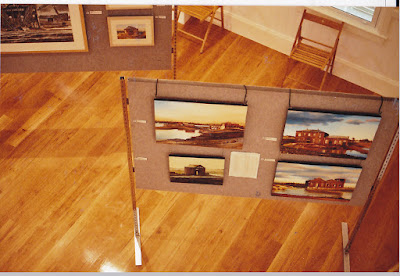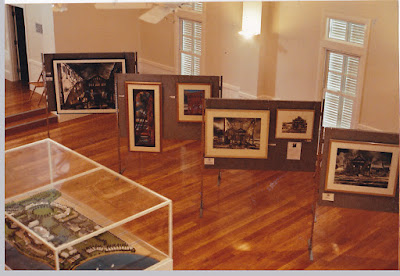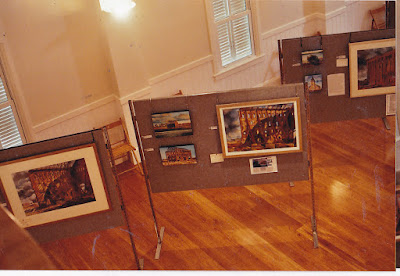.jpg) |
| P800 Sydney Harbour from Pyrmont 2023 oil on canvas 122 x 183cm |

.jpg) |
| P800 Sydney Harbour from Pyrmont 2023 oil on canvas 122 x 183cm |
wake up
look around
memorise what you see
it may be gone tomorrow
everything changes. Someday
there will be nothing but what is remembered
there may be no-one to remember it.
Keep moving
wherever you stand is ground zero
a moving target is harder to hit
"Ground Zero" by Michael Dransfield
 |
| AGL38 'AGL Site, Mortlake' 2004 oil on canvas 75 x 100 cm Available for sale |
 | |
| Exhibition of AGL site Mortlake paintings in Breakfast Point Community Centre 2004 |


Exhibition of AGL site Mortlake paintings
in Breakfast Point Community Centre 2004
The former
AGL Gasworks site has now been completely redeveloped into the controversial new gated suburb of Breakfast Point by Rosecorp.
The complex of white and pale beige apartments and townhouses is totally
unrecognizable from its industrial past.

Exhibition of AGL site Mortlake paintings
in Breakfast Point Community Centre 2004
To coincide with the opening of their new suburb, Rosecorp and the CFMEU jointly invited me to hold a solo exhibition in their freshly built Community Hall.
My paintings consisted almost entirely of renditions of the C.W.G. Building, which had recently been demolished.
Irony totally intentional.
Related Posts
 |
| AWW1 'Watching the forge fires fade 1 'William Wallbank + Sons' 187 Parramatta Road' 2016 oil on canvas 56 x 76cm Available |
 |
| AWW2 'Watching the forge fires fade ('William Wallbank + Sons' ) 2016 oil on canvas 61 x 91cm Highly Commended 2016 Auburn Art Prize Available |
 |
| AWW2 'Watching the forge fires fade ('William Wallbank + Sons' ) 2016 oil on canvas 61 x 91cm Highly Commended 2016 Auburn Art Prize Available |
 |
| AWW2 'Watching the forge fires fade ('William Wallbank + Sons' ) 2016 oil on canvas 61 x 91cm Highly Commended 2016 Auburn Art Prize Available |
 | ||
| AWW2 'Watching the forge fires fade ('William Wallbank + Sons' ) 2016 oil on canvas 61 x 91cm Highly Commended 2016 Auburn Art Prize Available |
 |
| AWW3 'Watching the forge fires fade 3- 'William Wallbank + Sons' 187 Parramatta Road' 2016 oil on canvas 51 x 71cm Available |
 |
| AWW4 'Rust Bucket' 7 ton ladle, William Wallbank + Sons foundry 2017 oil on canvas 122 x 91cm PRIVATE COLLECTION : SYDNEY |
 |
'Vivid - Sydney Harbour Bridge from Lavender Bay (Rainbow lights)' 2015 oil on canvas 102 x 200cm SOLD Enquiries about other Sydney Harbour paintings
Brett Whiteley often painted the magnificent view from Lavender Bay. It looks even better at night, however I don't think that many other artists have painted nocturnes of Sydney Harbour. |


 |
"Dalgety Terrace Millers Point"
2014 oil on canvas 46 x 61cm Collection : Mitchell Library, State Library of NSW Enquiries about similar paintings
The Harbour Control Tower looms ominously over the row of ramshackle terraces on the sandstone block wall of Dalgety Road.
Some of the houses sport protest banners :"Millers Point not 4 sale" "Our community is worth more than money"
Fortunately some of the banners were still there long enough for me to paint them, however, a few weeks afterwards the Housing NSW Millers Point Relocation Team had torn them down.
Housing NSW's Relocation Officers and their security and "cleansing" teams have been removing banners and photos of residents throughout Millers Point. The banners on the Garrison Church Rectory and on St Brigid's Church were removed in January 2015.
"Dalgety Terrace Millers Point"
2014 oil on canvas 46 x 61cm Collection : Mitchell Library, State Library of NSW Enquiries about similar paintings
Luckily I finished painting this canvas just before the roadwork started.
I was set up between 2 of the hideous new apartments built several years ago to replace a set of old Maritime Services Board warehouses.  |
"Dalgety Terrace Millers Point"
2014 oil on canvas 46 x 61cm Collection : Mitchell Library, State Library of NSW Enquiries about similar paintings
To add insult to injury,there is now a serious attempt to remove even the name "Millers Point" from the suburb- see Don't erase Millers Point Facebook Page
This canvas, which I exhibited in my solo exhibition "Under the Hammer" Frances Keevil Gallery 2014, was recently acquired for the collection of the Mitchell Library, State Library of NSW.
My canvases are banners that can never be torn down.
|
 |
| GIHC16 'Detail Hammerhead Crane' 2014 oil on canvas 28 x 36cm SOLD PRIVATE COLLECTION : SYDNEY |
 |
| GIHC18 'Girder, Hammerhead Crane 2014 oil on canvas 61 x 91cm FINALIST : 2015 HORNSBY ART PRIZE Enquiries |
 |
| GIHC20 'Under the Hammerhead Crane' 2014 oil on canvas 61 x 91cm Enquiries |